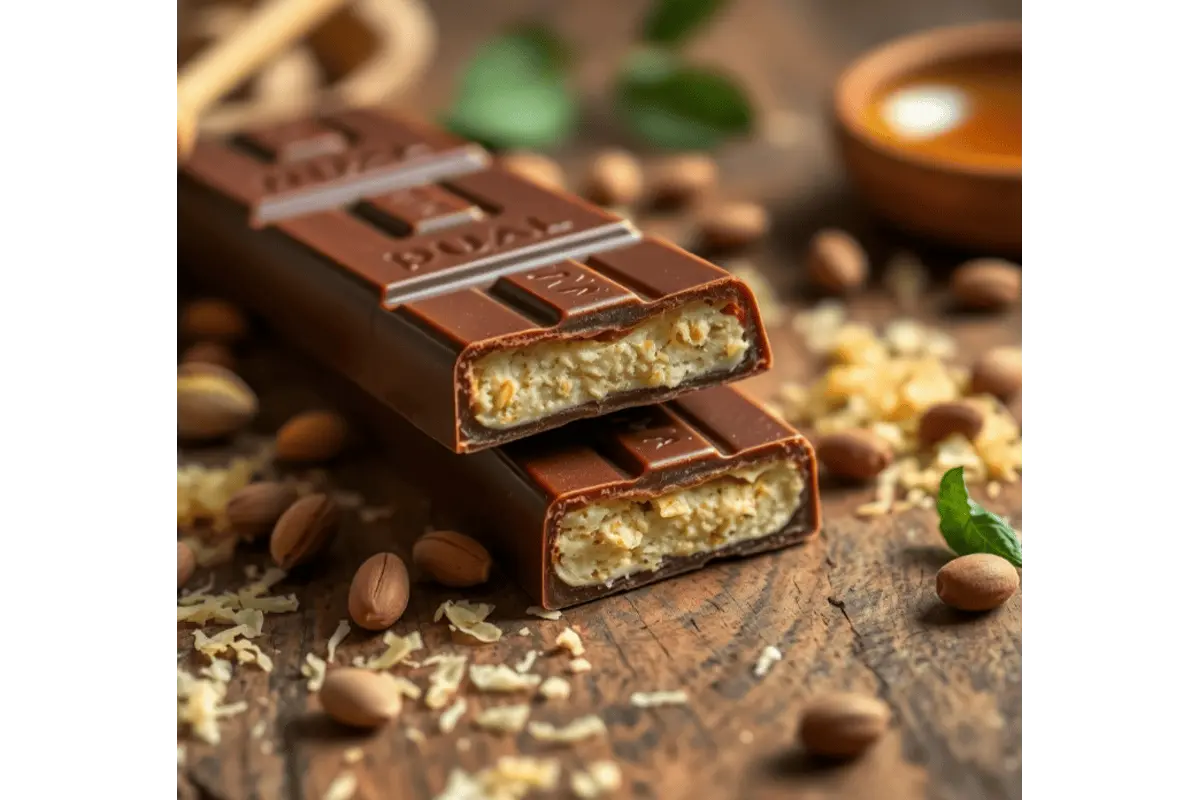The Dubai Chocolate Bar has quickly risen to global fame, captivating dessert enthusiasts with its unique combination of ingredients and irresistible flavor profile. Originating from Dubai, this decadent treat blends Middle Eastern culinary influences with the indulgence of rich chocolate. In this guide, we’ll walk you through the Dubai Chocolate Bar recipe, explain its cultural significance, and provide helpful tips for recreating this viral treat at home.
Introduction to the Dubai Chocolate Bar
The Dubai Chocolate Bar offers a one-of-a-kind dessert experience. It features a crispy kataifi (shredded phyllo dough) core, enveloped in a creamy pistachio paste and tahini filling, all wrapped in a rich milk chocolate shell. This combination of sweet, salty, creamy, and crispy elements has made the dessert a standout. Moreover, it’s especially popular on social media platforms like TikTok, where it went viral for its exotic appearance and luxurious taste.
What makes the Dubai Chocolate Bar recipe so intriguing is its ability to blend Middle Eastern and Western influences. After gaining viral fame, many home bakers began trying to replicate this dessert at home, bringing the flavors of Dubai to kitchens around the world. As a result, this recipe has become a must-try for anyone interested in unique, flavorful desserts.
Cultural and Culinary Significance of the Dubai Chocolate Bar
The Dubai Chocolate Bar merges traditional Middle Eastern ingredients with modern techniques. Historically, Middle Eastern desserts often feature ingredients like pistachios, tahini, and kataifi, which have been part of regional cuisine for centuries. These flavors are now married with rich milk chocolate, creating a fusion that’s both innovative and nostalgic.
Kataifi, the shredded phyllo dough, forms the crispy base of the Dubai Chocolate Bar. This dough is central to many Middle Eastern desserts like knafeh, offering a satisfying texture that contrasts with the creamy, nutty filling. Furthermore, pistachio paste and tahini are both common ingredients in Middle Eastern sweets, providing a depth of flavor that complements the richness of the chocolate. By combining these familiar flavors with milk chocolate, the Dubai Chocolate Bar creates a harmonious balance of tastes and textures that appeal to a wide audience.
The Viral Phenomenon Behind the Dubai Chocolate Bar
Social media has played a massive role in the Dubai Chocolate Bar’s rise to fame, especially platforms like TikTok. In particular, videos of the dessert, where the chocolate shell is cracked open to reveal the gooey pistachio and tahini filling, captured the attention of millions. This visually striking dessert quickly became a sensation, inspiring many to recreate it at home.
What makes these videos so captivating is the mesmerizing moment when the chocolate shell breaks apart, showing the creamy filling. The dessert’s ability to showcase multiple textures in one bite contributed significantly to its viral success. Thus, TikTok’s viral power helped propel the Dubai Chocolate Bar into the global spotlight, demonstrating how social media can turn a local dessert into a worldwide food phenomenon.
Key Ingredients for the Dubai Chocolate Bar Recipe
Creating the Dubai Chocolate Bar requires a few key ingredients, each contributing to the dessert’s unique texture and taste. Let’s take a closer look at the most important ingredients:
- Kataifi (Shredded Phyllo Dough): The crispy base of the Dubai Chocolate Bar, kataifi gives the dessert a delicate crunch. Made from thin shreds of phyllo dough, it creates a light, crispy layer that contrasts beautifully with the smooth filling.
- Pistachio Paste: This creamy paste, made from finely ground pistachios, serves as the filling’s main flavor. Additionally, it gives the bar a rich, nutty taste and a velvety texture.
- Tahini: A paste made from sesame seeds, tahini adds a slightly bitter, nutty flavor that enhances the pistachio filling. It also complements the sweetness of the chocolate, balancing the dessert’s flavor.
- Milk Chocolate: The outer shell of the bar is made with smooth milk chocolate, which adds sweetness and richness. It envelops the crispy kataifi and creamy filling to create a decadent, indulgent treat.
Ingredient Quality Matters
The quality of each ingredient plays a crucial role in the success of this dessert. For the best results, use fresh pistachios, high-quality milk chocolate, and authentic kataifi dough, which can often be found at Middle Eastern grocery stores or specialty shops.
Step-by-Step Preparation Guide
Now, let’s walk through the process of making the Dubai Chocolate Bar at home. By following these steps, you can successfully recreate this viral treat with ease.
Step 1: Prepare the Kataifi
- Preheat the Oven: Set your oven to 350°F (175°C).
- Shred the Kataifi: Gently pull apart the kataifi dough to create fine strands. If you’re using store-bought kataifi, simply separate the strands to ensure even baking.
- Bake the Kataifi: Spread the kataifi evenly on a baking sheet, then bake for about 10 minutes or until golden brown and crispy.
- Cool: Allow the kataifi to cool completely before moving on to the next step.
Step 2: Make the Pistachio and Tahini Filling
- Prepare the Pistachios: In a food processor, grind the pistachios until they form a smooth paste. You may need to add a small amount of vegetable oil or syrup to help with the blending process.
- Combine with Tahini: In a separate bowl, combine the pistachio paste with tahini and stir until fully incorporated, forming a creamy filling.
- Set Aside: Let the filling chill in the fridge for 10-15 minutes, allowing it to firm up before using it.
Step 3: Prepare the Chocolate Shell
- Melt the Milk Chocolate: In a microwave-safe bowl, melt the milk chocolate in 30-second intervals, stirring each time until smooth and melted.
- Coat the Mold: Pour a thin layer of melted chocolate into the bottom of your chocolate bar mold. Ensure it covers the sides evenly.
- Chill: Place the mold in the fridge for about 10-15 minutes to allow the chocolate shell to set.
Step 4: Assemble the Dubai Chocolate Bar
- Add the Kataifi: Once the chocolate shell has set, fill the mold with the crispy kataifi. Ensure the layer is even and fully covered.
- Add the Pistachio-Tahini Filling: Spoon the pistachio-tahini filling over the kataifi layer, smoothing it with a spatula.
- Seal with Chocolate: Pour the remaining melted chocolate over the filling to cover it completely. Tap the mold gently to remove air bubbles.
- Chill Again: Place the mold in the fridge for at least 1-2 hours until the chocolate has fully set and hardened.
Variations and Substitutions
While the traditional Dubai Chocolate Bar recipe is fantastic as is, there are a few variations you can try to suit your preferences:
- Dark Chocolate: For a richer, more intense flavor, use dark chocolate instead of milk chocolate. The bitterness of the dark chocolate pairs beautifully with the creamy pistachio and tahini filling.
- Nut Substitutes: If you’re not a fan of pistachios, you can experiment with other nuts like hazelnuts or almonds. Simply grind them into a smooth paste to create the same creamy filling texture.
- Flavored Syrups: Enhance the filling with a touch of flavored syrup, such as rose water or orange blossom, to add a subtle floral note to the dessert.
Serving Suggestions and Pairings
The Dubai Chocolate Bar is delicious on its own, but pairing it with complementary flavors can elevate the experience:
- Coffee Pairing: A strong espresso or cappuccino makes an excellent pairing. The bitterness of the coffee balances the sweetness of the chocolate, creating a delightful contrast.
- Ice Cream: For a refreshing touch, serve the Dubai Chocolate Bar with a scoop of pistachio or vanilla ice cream. The cold ice cream contrasts nicely with the warm, rich chocolate.
- Wine Pairing: Sweet dessert wines, such as Moscato or Vin Santo, pair wonderfully with the Dubai Chocolate Bar. These wines complement the dessert’s rich flavors and provide a sophisticated touch.
Storing and Freezing Dubai Chocolate Bars
If you want to make the Dubai Chocolate Bar ahead of time, storing it properly is key to maintaining its texture and flavor.
Storing the Bars
- Room Temperature: Store the Dubai Chocolate Bar in an airtight container at room temperature for up to 3-5 days. Make sure the container is kept in a cool, dry place, away from direct sunlight.
- Refrigeration: If you plan to keep the bars for longer, refrigerate them. The bars will stay fresh for up to a week when stored in the fridge.
Freezing the Bars
To store the Dubai Chocolate Bars for an extended period, freezing is the best option:
- Freeze Individually: Wrap each bar tightly in plastic wrap and store them in a zip-top bag or airtight container. The bars can be frozen for up to a month.
- Thaw Before Serving: Allow the bars to thaw at room temperature for 30 minutes before serving. This ensures that the filling remains smooth and creamy.
FAQs About the Dubai Chocolate Bar Recipe
1. Can I use phyllo dough instead of kataifi?
Yes, you can use phyllo dough as a substitute. Just shred it into fine strands and bake until crispy, similar to kataifi. The texture may vary slightly, but it will still work.
2. How do I make pistachio paste at home?
To make pistachio paste, blend shelled pistachios in a food processor until smooth. You can add a little oil or syrup to help achieve the desired consistency.
3. Can I use dark chocolate instead of milk chocolate?
Yes, using dark chocolate will give the Dubai Chocolate Bar a deeper, richer flavor that pairs perfectly with the nutty filling.
Conclusion
The Dubai Chocolate Bar is a luxurious and unique dessert that combines the best of Middle Eastern ingredients with the indulgence of rich chocolate. With its crunchy kataifi base, creamy pistachio-tahini filling, and smooth milk chocolate shell, this dessert offers an unforgettable experience. Follow this step-by-step guide to recreate the Dubai Chocolate Bar in your own kitchen, and enjoy the flavors of Dubai at home.
For more dessert inspiration, check out this article on 31 Of The Best Italian Dessert Recipes.


1 thought on “The Ultimate Guide to the Dubai Chocolate Bar Recipe”